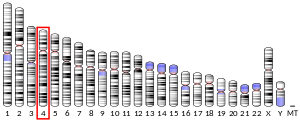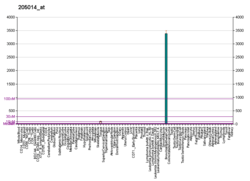FGFBP1
Fibroblast growth factor-binding protein 1 is a protein that in humans is encoded by the FGFBP1 gene.[5][6][7]
FGFBP1, or HBP17, binds to both acidic (FGF1; MIM 131220) and basic (FGF2; MIM 134920) fibroblast growth factors in a reversible manner. It also binds to perlecan (HSPG2; MIM 142461).[supplied by OMIM][7]
Interactions
FGFBP1 has been shown to interaction with Perlecan.[5]
gollark: Okay, I'll go skim that.
gollark: It would probably help to use less awful voting systems.
gollark: Well, I'm waiting for their explanation on 1, 2 sounds like the thing I said would be bad, 3... maybe?, 4 doesn't seem like a problem, and 5 might be something dislikeable but not right wing extremism.
gollark: mautam has other reasons, I mean.
gollark: I would agree with that - having the minimum standard be "immediately disavow anything some group decides they don't like" would be intensely problematic - but maybe they have other reasons.
References
- GRCh38: Ensembl release 89: ENSG00000137440 - Ensembl, May 2017
- GRCm38: Ensembl release 89: ENSMUSG00000048373 - Ensembl, May 2017
- "Human PubMed Reference:". National Center for Biotechnology Information, U.S. National Library of Medicine.
- "Mouse PubMed Reference:". National Center for Biotechnology Information, U.S. National Library of Medicine.
- Mongiat M, Otto J, Oldershaw R, Ferrer F, Sato JD, Iozzo RV (Mar 2001). "Fibroblast growth factor-binding protein is a novel partner for perlecan protein core". J Biol Chem. 276 (13): 10263–71. doi:10.1074/jbc.M011493200. PMID 11148217.
- Wu DQ, Kan MK, Sato GH, Okamoto T, Sato JD (Oct 1991). "Characterization and molecular cloning of a putative binding protein for heparin-binding growth factors". J Biol Chem. 266 (25): 16778–85. PMID 1885605.
- "Entrez Gene: FGFBP1 fibroblast growth factor binding protein 1".
Further reading
- Abuharbeid S, Czubayko F, Aigner A (2006). "The fibroblast growth factor-binding protein FGF-BP". Int. J. Biochem. Cell Biol. 38 (9): 1463–8. doi:10.1016/j.biocel.2005.10.017. PMID 16324873.
- Lange LG, Sytkowski AJ, Vallee BL (1976). "Human liver alcohol dehydrogenase: purification, composition, and catalytic features". Biochemistry. 15 (21): 4687–93. doi:10.1021/bi00666a023. PMID 9982.
- Czubayko F, Liaudet-Coopman ED, Aigner A, et al. (1997). "A secreted FGF-binding protein can serve as the angiogenic switch in human cancer". Nat. Med. 3 (10): 1137–40. doi:10.1038/nm1097-1137. PMID 9334727.
- Wang XC, Chen JH, Crab JW, Sato JD (1998). "Purification of heparin-binding protein HBp17 and identification of HBp17 heparin binding site". Biochem. Mol. Biol. Int. 46 (1): 81–7. doi:10.1080/15216549800203582. PMID 9784842.
- Harris VK, Coticchia CM, Kagan BL, et al. (2000). "Induction of the angiogenic modulator fibroblast growth factor-binding protein by epidermal growth factor is mediated through both MEK/ERK and p38 signal transduction pathways". J. Biol. Chem. 275 (15): 10802–11. doi:10.1074/jbc.275.15.10802. PMID 10753873.
- Sauter ER, Nesbit M, Tichansky D, et al. (2001). "Fibroblast growth factor-binding protein expression changes with disease progression in clinical and experimental human squamous epithelium". Int. J. Cancer. 92 (3): 374–81. doi:10.1002/ijc.1207. PMID 11291074.
- Chen JH, Wang XC, Sato JD (2001). "Bifunctional effects of heparin-binding protein HBp17 on DNA synthesis in cells". Cell Biol. Int. 25 (6): 567–70. doi:10.1006/cbir.2000.0688. PMID 11407864.
- Tassi E, Al-Attar A, Aigner A, et al. (2001). "Enhancement of fibroblast growth factor (FGF) activity by an FGF-binding protein". J. Biol. Chem. 276 (43): 40247–53. doi:10.1074/jbc.M104933200. PMID 11509569.
- Strausberg RL, Feingold EA, Grouse LH, et al. (2003). "Generation and initial analysis of more than 15,000 full-length human and mouse cDNA sequences". Proc. Natl. Acad. Sci. U.S.A. 99 (26): 16899–903. doi:10.1073/pnas.242603899. PMC 139241. PMID 12477932.
- Gerhard DS, Wagner L, Feingold EA, et al. (2004). "The status, quality, and expansion of the NIH full-length cDNA project: the Mammalian Gene Collection (MGC)". Genome Res. 14 (10B): 2121–7. doi:10.1101/gr.2596504. PMC 528928. PMID 15489334.
- Beer HD, Bittner M, Niklaus G, et al. (2005). "The fibroblast growth factor binding protein is a novel interaction partner of FGF-7, FGF-10 and FGF-22 and regulates FGF activity: implications for epithelial repair". Oncogene. 24 (34): 5269–77. doi:10.1038/sj.onc.1208560. PMID 15806171.
- Rual JF, Venkatesan K, Hao T, et al. (2005). "Towards a proteome-scale map of the human protein-protein interaction network". Nature. 437 (7062): 1173–8. doi:10.1038/nature04209. PMID 16189514.
- Xie B, Tassi E, Swift MR, et al. (2006). "Identification of the fibroblast growth factor (FGF)-interacting domain in a secreted FGF-binding protein by phage display". J. Biol. Chem. 281 (2): 1137–44. doi:10.1074/jbc.M510754200. PMID 16257968.
- Ray PE, Tassi E, Liu XH, Wellstein A (2006). "Role of fibroblast growth factor-binding protein in the pathogenesis of HIV-associated hemolytic uremic syndrome". Am. J. Physiol. Regul. Integr. Comp. Physiol. 290 (1): R105–13. doi:10.1152/ajpregu.00492.2005. PMID 16352855.
- Lim J, Hao T, Shaw C, et al. (2006). "A protein-protein interaction network for human inherited ataxias and disorders of Purkinje cell degeneration". Cell. 125 (4): 801–14. doi:10.1016/j.cell.2006.03.032. PMID 16713569.
This article is issued from Wikipedia. The text is licensed under Creative Commons - Attribution - Sharealike. Additional terms may apply for the media files.




